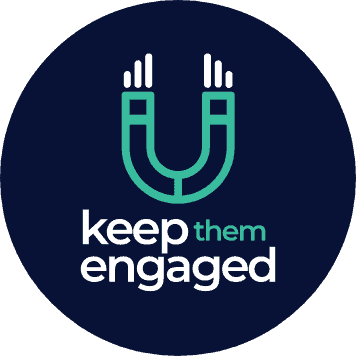Gamification has been a huge buzzword for a period of time, which compelled a lot of organizations in starting to launch their own gamification projects.
I can understand why, marketers and would-be experts have positioned gamification as a simple magic bullet which makes people continue using any kind of product or service.
Well, the short answer is that gamification can be helpful in engaging your clients or users but there are several false assumptions about what gamification is and especially what it is not. I have written a summary about what gamification is not in case you’re curious.
Now as mentioned a lot of organization launched gamification projects with the goal to keep their users engaged with their product or service. The issue is that deploying good gamification is quite difficult.
In this article I have compiled a list of gamification failures to give you an idea of how gamification really shouldn’t be applied. I hope this helps you in avoiding gamification mistakes.
Also, this list was surprisingly hard to create because there is not a lot of information about gamification failures publicly available.
Anyway, let’s dive in.
Pokémon Go Fails to Engage Long-Term
This game, developed by Niantic based in San Francisco, could have had the opportunity to fulfill every 90’s kids dreams. The value proposition of this game was absolutely amazing, and the nostalgia effect of playing something, a lot of 90’s kids have been spending months with helped certainly to make this game so successful.
But Niantic also incorporated some cool gamification concepts to keep people engaged but sadly failed at one specific thing, which was ultimately responsible for losing all their users later on.
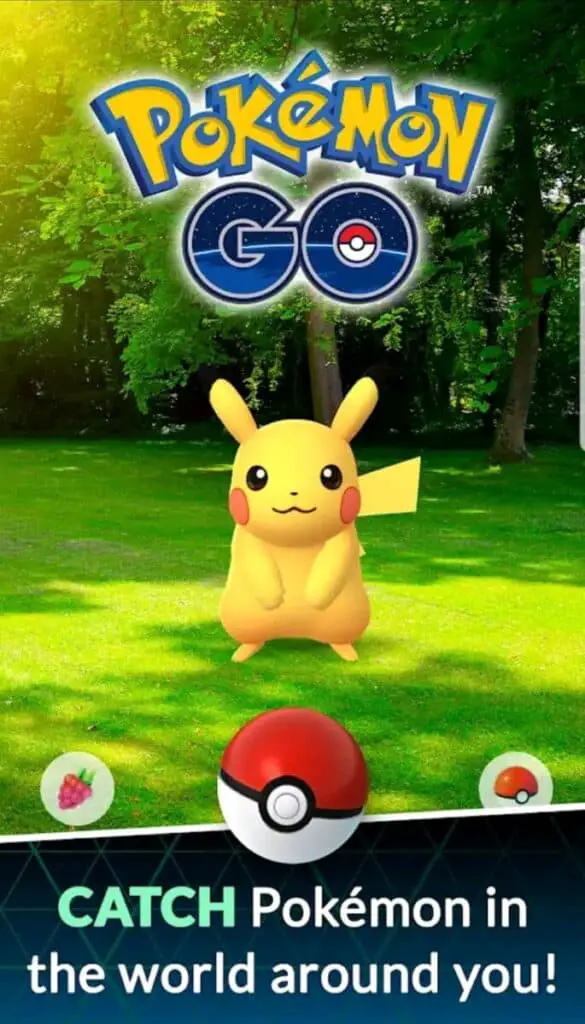
What they’ve done well is that Pokémon Go has amazing story telling elements, go outside catch Pokémon and become a Pokémon trainer, pretty much every 90’s kid dream.
They also focused a lot on creating this collector’s mindset – you gotta catch’em all – think of someone who vividly collected stamps or coins. However, they have sadly missed two things.
For one, the majority of their users wasn’t a hardcore Pokémon Go player. Which means that they would usually only occasionally play the game while for example going to the store, and sometimes going for a walk to check the surroundings for Pokémon’s – but that was rarer.
Whereas other players would go completely nuts on this and go outside, go to various places try to collect any Pokémon which puts them so far ahead against other players that it became frustrating and boring for both sides to continue.
And second, at first it might be fun to go outside and check the neighborhood for Pokémon’s. My friends back then who were the laziest people on earth even met up and walked around outside during snowstorms to catch Pokémon’s together.
The problem is that after a while the reward you get, to add another Pokémon to your collection isn’t motivating enough to do this extra “task” during a day.
This is called extrinsic motivation, like having a job and being rewarded with a salary is an example for this type of motivation.
Keeping people motivated over a longer period without the need of being constantly rewarded is a major factor in designing great gamification.
Think of reading a book because you simply like reading – there isn’t someone who’s paying you to read this book, you read it because you want to.
This feeling of being forced to go outside otherwise you won’t succeed is a significant reason Pokémon Go has lost its huge user base.
Frequent Flyer Programs Don’t Tee Up Game Elements
Miles&More, one of the biggest frequent flyer programs in Europe with more than 25 million members, lastly measured in 2014 is a fitting example to illustrate this. It’s also one of my favorite frequent flyer programs and my most used one since I’m personally an avid flyer.
The idea of any frequent flyer program is to encourage people to fly with a participating airline from the frequent flyer program. If you do fly with an airline inside that circle you can receive two different types of miles: status miles and award miles.
Usually award miles are like money, you can earn them by spending money on services which participate in the frequent flyer program. For example, Miles&More gives you award miles for flying, car rental, hotels, sometimes even refilling gas, and much more.
You can also spend award miles on the like by purchasing an upgrade for a flight or exchanging it for a luggage at the shop and so on. The other type, so-called status miles cannot be redeemed and are only there to check which status you belong to.
Usually, you need to fly a certain number of times to receive enough status miles to receive the e.g., frequent flyer status. This gives you then access to exclusive lounges, with food coffee and WIFI.
This concept of having some sort of award or currency, which is used to trade or represent status, is one of the most common gamification elements in use across all gamification projects.
And there are a lot of people, like me who really enjoy getting these frequent flyer miles every time you fly. Or even better getting free breakfast at the airport once you have the frequent flyer status.
But and this is what a lot of frequent flyer programs have not taken into consideration, just the fact that game elements are included doesn’t make the experience exceptionally fun or engaging.
Especially if the threshold for an e.g., frequent flyer status is just really high, which might demotivate travelers who’re not flying often to even sign up.
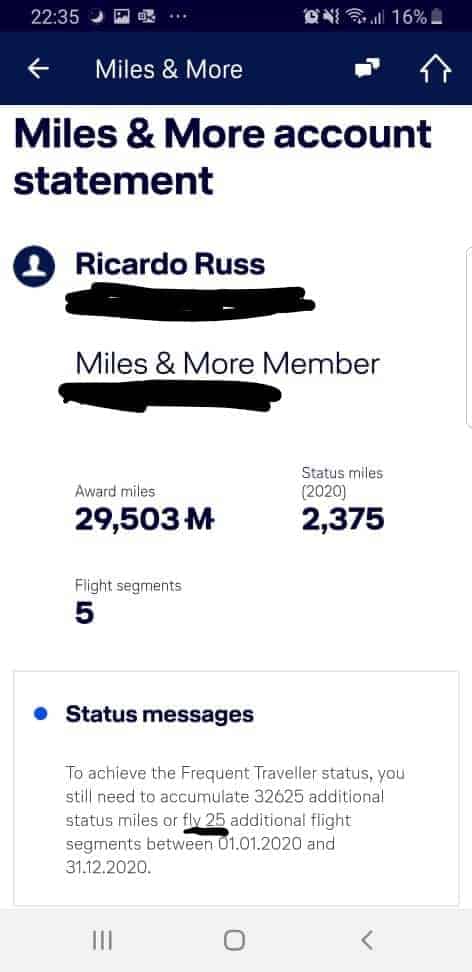
Of course, there are some hardcore frequent flyers who try to optimize every dollar they spend to get more miles and such, but the majority is not going to be engaged or interested enough in doing this.
As a side note, I for example have used airline credit cards in which every dollar you spent transfers into award miles. I set it up that my apartment rent is deducted from that account every month. I then turn around and use the miles to get cheaper prices on hotels, car rentals and other stuff.
This is a personal example, please do your own research before applying this to your own situation.
The takeaway from this is that most of the frequent flyer programs have simply added gamification elements such as award and status miles but have not successfully tied these elements together nor considered that the bar to get an interesting reward is quite high.
“Not all rewards are fun, and sadly not all fun is rewarding”.
Kevin Werbach – Gamification professor
Classroom Gamification Focused Only on PLBs
I found this example in an academic study here and thought that this one is certainly worth sharing. The summary is that a teacher has tried to implement gamification in his classroom.
He wanted to motivate and encourage his students to finish homework, show up on time or simply attend a class. At the same time the concept of experience points (XP) should replace traditional grades.
So, what he has tried to do was to hand out experience points (XP) for a completed task. For example, if you simply showed up you get XP points, if you then turned in your homework you get more XP points. Based on the number of XP points you have; your grade will be calculated.
You can see in the picture below the very well thought out reward structure:
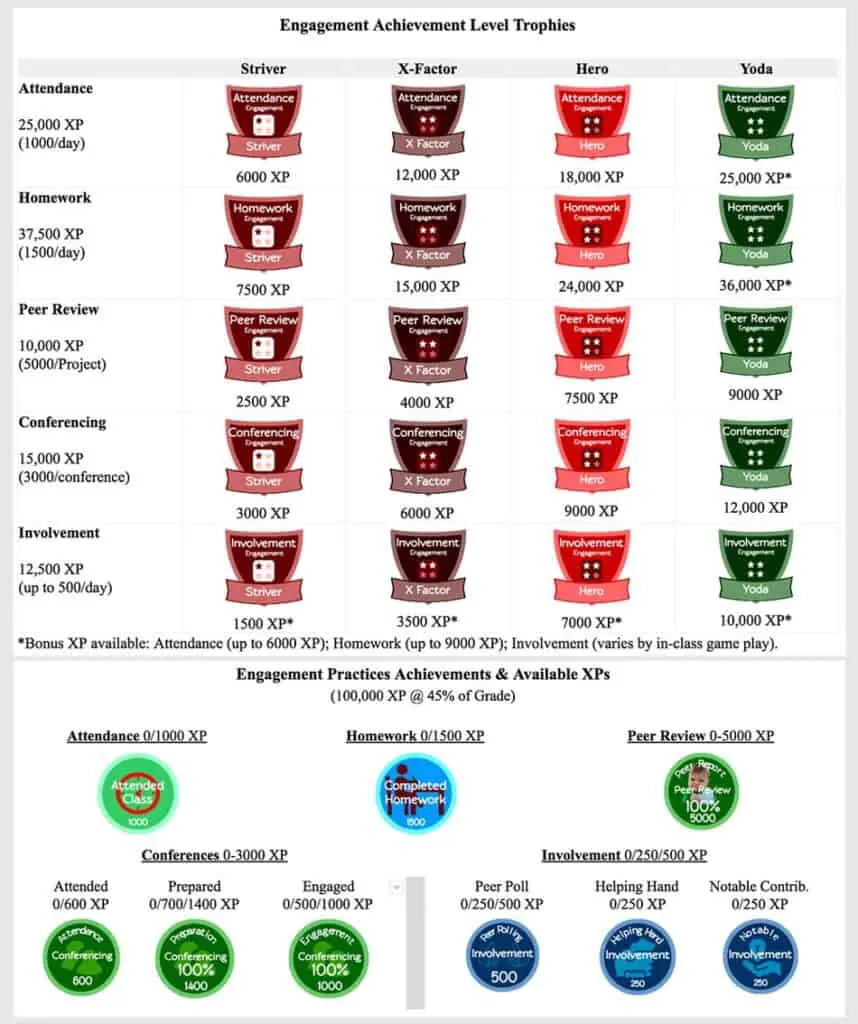
To be clear the teacher has done a fabulous job on trying to implement gamification with the knowledge he had. He realized however that the points and leaderboards, even the badges didn’t make the act of learning super engaging and decided to ultimately revert back to the normal style of teaching.
Sadly, and this really pains me because he has invested a lot of time into this, the teacher has fallen into the most common mistake when implementing gamification: he only focused on points, leaderboards, and badges (PLBs) and assumed that just by incorporating game elements, it must make an experience automatically fun and engaging.
He also developed a card game to make it more fun, but this right here is why many gamification projects have failed. The assumption that gamification is only adding some points, leaderboards and badges will make an experience fun is not true – there is so much more to consider when designing good gamification.
I have fallen into a similar trap before I spent my days with gamification. To make it easier for you so you don’t have to waste time on researching, I have written an article about what gamification is not and highly suggest browsing through it, so this doesn’t happen to you as well.
There are several problems with this approach the most pressing in my opinion is, that there wasn’t any real motivation inserted into the student’s study cycle.
Yes, if you showed up in time you received experience points, but what is the value of these points other than gaining a badge. Especially since points have been gained simply by attending a class which, to my knowledge is usually mandatory.
Of course, it is hard to judge from the outside but in this case spending more time on what motivates a student, is it a reward or some other form of intrinsic motivation coupled with tackling challenging tasks, all of it wrapped in an interesting story could have provided different results.
Again, achieving good gamification is hard, and I personally commend the teacher’s willingness to try and really wished that his test succeeded. Especially since gamification can bring an immense value to the area of education.
Google News Handed Out Badges Without Value
If you have an android phone, then you sometimes receive these notifications on your phone about something happening in your surroundings or something which might interests you.
Or at least what Google thinks might interest you, and personally I enjoy these push notifications since they are usually quite short and tell what I need to know.
However, this service from Google has been around since 2002 and started off with the simple goal to encourage people to read Googles accumulated news in Googles News Reader, or to switch on the notification service to receive the news.
In an effort to encourage more people to read their news they used a well-known gamification element: badges.
In this case, Google designed it that if a user reads a story or a news article with Google News, he or she would be awarded badges based on the topics the user would read.
In addition, the user would simply level up by reading more news. A user could then go ahead and display them on their profile page to showcase how much he or she is reading.
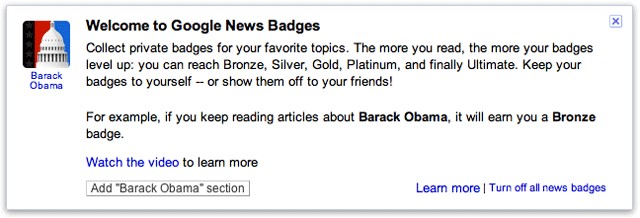
The unfortunate flaw here was that these badges simply do not have any kind of meaning or value to the users.
Because with these badges you couldn’t really do anything except showcasing them on their profile or posting them on your social media.
Since users were getting them for simply reading News articles there wasn’t much of a drive to get more badges. A number of users actually quit using Google News, because they didn’t want to display what they were reading.
Zappos Didn’t Explain The Value of Their Rewards
Zappos is a substantial shoe and clothing retailer which has gotten acquired by Amazon in 2009 for $1.2 billion at the time.
Zappos is also known for its great customer experience, they have an entire page listing out their benefits, such as being able to call 24/7 and much more.
Which is why it was quite the surprise to see how they have, back then tried to incorporate gamification to increase their engagement. Zappos planned on using badges, levels and points to, I guess show their customers that they are valued.

I’m so vague about it because I’m not sure what the point of the badges were. For starters, if you have reached the level of a VIP customer you received free shipping and the like – keep in mind this was before Amazon Prime.
They then started to introduce badges, levels, and points on user profiles, which at first made their customer and users quite excited.
That however faded rather quickly because no one understood how you received these awards or how and what you can use them for.
For the user, these badges, levels and points seemed to have no value other than looking pretty at one’s profile.
Needless to say, that Zappos quickly scratched the program, especially since this might have hurt their image while engaging with their VIP customers at the time.
Sales Contests at Telecom Companies Don’t Motivate
Sales competitions are used in almost every industry. These are especially popular at telecommunication companies which are selling internet and telephone contracts. You know, these pay X months a fixed price to receive unlimited calls, internet, and a free phone (not free at all but sure), sort of deals.
Now the managers in these stores regularly run sales contests to increase productivity among their employees which can be considered gamification. I know that a Swedish telecommunication company is using these sales contests because a close friend of mine has worked there for several years.
My friend asked me not to reveal the company name but I’m sure that you still get the point.
Now the idea of these contests is that the manager offers a price for whoever finishes at the top of the leaderboard. This should in theory encourage everyone to work as hard as possible to sell more contracts right.
The problem is that these contests often fail to motivate the majority of the sales team. What usually happens is that a few really good sales people find themselves constantly at the top of the leaderboard – therefore receiving all the prices.
The thing is that these guys usually don’t need an external motivation factor, usually these people are driven by their own desire and simply want to perform to the best of their abilities.
Now the other sellers who find themselves in lower to middle class rankings are the ones who would actually benefit from the competitive motivator. Unfortunately, they usually see that the competition is too good to even try. So, in many cases they won’t, unless they absolutely must, if they do not want to get fired.
In general sales contests are a great way for engaging employees, however they usually are poorly executed, rely way too much on rewards but also fail to engage every user regardless of their current leaderboard position.
Wuppermann Steel Focused on Highlighting Failures
Let’s talk about the example of Wuppermann Steel, a German steel manufacturer company based in Leverkusen. They have plants in a number of different locations, one of which is in The Netherlands close to Amsterdam.
Side fact: The soccer team is called Bayer Leverkusen because a few employees of the pharmaceutical company “Bayer” founded the club. The name can be confusing to the more famous soccer team FC Bayern Munich. There is however no common ground between them.
The management of the Amsterdam plant has tried to incorporate gamification to make workers more aware of the number of safety incidents and stoppages. Which is a, if executed properly wonderful use for gamification.
However, they created a dashboard displaying all the incidents and stoppages, but it also highlighted the workers individual scores, in particular how well they were doing compared to their fellow colleagues on a leaderboard.
The idea was to start a friendly competition to encourage colleagues to reduce the number of incidents. The problem is that if there aren’t any rewards and if the competition is based on how bad people are doing it creates frustration because people will always get reminded on what they did wrong.
This can demoralize staff and harm the workplace experience, which is why the organization has decided to stop the program.
Disney’s Gamification Only Highlighted Failures
This example is one of the clearest examples of poorly implemented gamification. Disneyland and Paradise Pier hotels have tried to measure productivity, which is a quite common practice in the hotel industry.
If you’re able to increase productivity just a couple of percentage points, bigger hotel chains will in most cases see a quite significant reduction of cost for example.
Meaning that gamifying work within a hotel context does make a lot of sense, Disney has in this case specifically tried to tackle the experience of doing laundry.
In the basement of their hotels, they had staff which took care of the hotel’s laundry using dozens of laundry machines, it goes without saying that this isn’t the most engaging or fun task, so I can definitely understand why they’ve tried to make the experience more fun.
Disney has installed monitors on their walls where their staff takes care of the laundry. On each monitor you saw a scoreboard which displays every employee’s efficiency speed. This number was illustrated right next to the employee’s name so everyone can see how quickly their colleagues are loading the pillowcases, sheets and other items into the laundry machine.
This efficiency speed number started the second an employee has clocked in and would display for example that worker Ricardo is on 37% efficiency.
Whereas right above Ricardo could be another colleague called Stephen, who has an efficiency rate of 70%. The employees closest to 100% would be highlighted in green, the rest has been marked in red.
Again, not the worst area to apply gamification, but in this case the execution could have been more thought through.
What happened was that by creating this competitive workplace, some employees tried to race to the top, which has created frustration within other employees who felt that a reasonable pace won’t be enough to satisfy the boss.
The employees even skipped bathroom breaks out of fear because every time they fell behind, they had to explain that to their boss. It comes as no surprise that this system has been described as “electronic whip” and has been taken down after some time.
Foursquare Gamification Discouraged Users
This example from Foursquare, is one of the most common examples of great initial gamification which resulted in a lot of users, but they ultimately lost their user base because of poorly executed end game stages.
Foursquare encouraged people to check-in at the places they visit, such as restaurants, coffee places, basically any kind of building which isn’t someone’s home. If you have checked in more times than any other user, you become the mayor of the venue. Which results in some benefits such as discounts, coupons and other stuff.
For example, if you visit a coffee please every day and use the check-in feature in foursquare and you’ve become the major of this coffee place, you might receive a discount on their menu.
The charm here is however that your name and your status as mayor is displayed in the foursquare app to everyone who is checking in at the venue as well. You’re somewhat famous, which is a pretty amazing feeling.
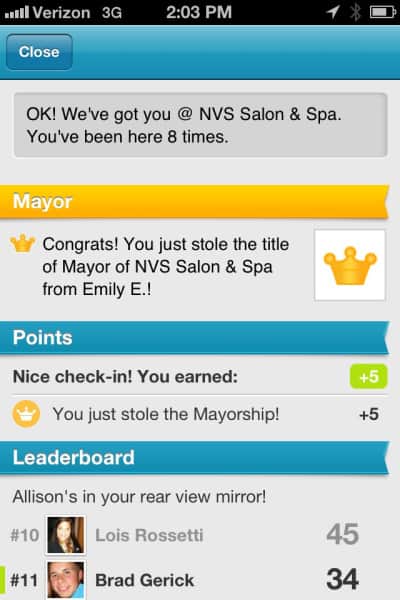
So far so good. The problem however arises as soon as some users have checked in so many times that it becomes impossible for other players to become the major anymore. And if there isn’t any perspective for going up or down the latter – well, users sadly quit.
If foursquare would have considered other stages, instead of just the major stage then maybe that could have helped in keeping their inexperienced users engaged so they keep using the application.
Mariott Failed to Explain The “Why”
Another example in the hotel industry is the example of the Mariott hotel (which I’m personally actually a great fan of). These guys have tried to develop a game which trains their hotel staff in their daily activities at their jobs.
The idea is that they have a safe environment to make mistakes, learn and memorize processes. Makes sense and is in principle a wonderful way to employ game elements.
However, back then they have unfortunately not educated their employees enough as to why an employee should play this game for X hours a day.
If they would have explained the benefits and how this game could help an employee in reducing mistakes and giving them a safe space to learn, it might have increased the chances of success.
Another factor why this might have failed is that the experience of playing this game was simply not motivating or engaging enough. An employee would play countless hours on tasks such as buying hamburger ingredients like lettuce or pickles.
This might be interesting the first couple of times but after a while this process just becomes tedious. Sadly, the learning experience in this form has been shut down.
Final Thoughts
I hope these examples help you to understand that gamification is not just based on leaderboards, points, and badges. There is a lot more behind the concept, but I hope these examples gave you an idea on how gamification should not be deployed so you save time and money in your own projects.
